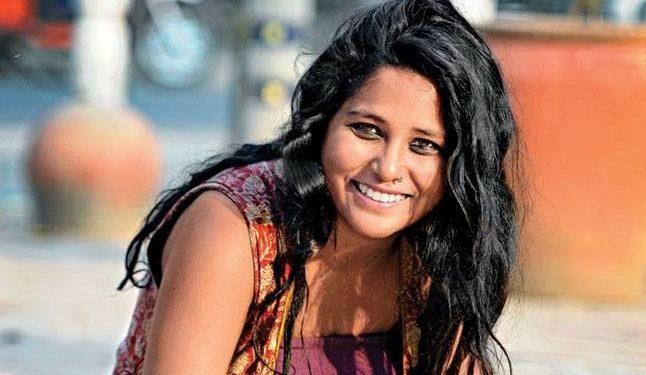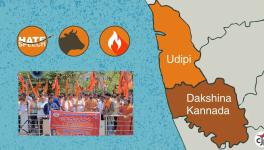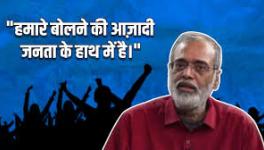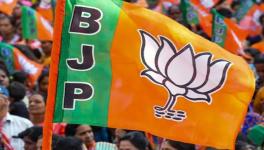What Was the Mysterious Conspiracy of Delhi Police Against Devangana Kalita?

Pinjra tod is a young organisation that shot to fame for challenging misogynistic norms on college campuses. Over the years it has grown and become a resounding voice on matters of civil liberty. Two of its activists, Natasha Narwal and Devangana Kalita, were arrested during the lockdown and charged with the draconian UAPA for their involvement in anti-CAA protests. the Delhi High Court granted Devangana Kalita bail yesterday and called her detention unjustified. Parth Maniktala, a student at the Faculty of Law, University of Delhi, analyses the story of Delhi Police, its FIRs, and the respective bail applications in which Devangana Kalita’s case has been caught up in.
——–
Delhi witnessed its worst anti-minority riots in decades in February this year. Of the 53 people killed, more than two-thirds were Muslim. Media reports indicated that a majority of the homes and shops that were looted and torched belonged to Muslims.
According to an investigation by Amnesty International India, the Delhi Police, which come under the jurisdiction of the Ministry of Home Affairs, were “complicit and an active participant” in the violence. The police were seen as acting with state-sponsored impunity. In fact, one of the survivors, Kaushar Ali, recalled the police saying to him, “Even if we kill you, nothing will happen to us.”
Months later, there are allegations that the Delhi Police are specifically targeting the anti-Citizenship Amendment Act protestors. With the lockdown imposed to contain the COVID-19 pandemic, the police arrested several students and activists – alleging their participation in the February riots.
Human Rights Watch said, “The authorities have failed to conduct impartial and transparent investigations into the violence.”
Proceedings Against Devangana Kalita
One such case is of Pinjra Tod founder, Devangana Kalita. She is an accused in as many as four FIRs relating to the anti-CAA protests and Delhi riots. On May 23, the police arrested Kalita and Natasha Narwal (co-founder of Pinjra Tod) under FIR 48/2020. They were granted bail the very next day. The Duty Magistrate, Ajeet Narayan, observed that there was “‘no reason to maintain the charge under Section 353 IPC” (the only non-bailable offence in the FIR), as “they were merely protesting against CAA and NRC”.
However, within minutes of the two being released, the Special Investigation Team of the Crime Branch produced a second FIR (50/2020) and sought to re-arrest them. This second FIR had far graver charges, including murder, attempt to murder, rioting, and criminal conspiracy. The court, eventually, remanded them to police custody for two days.
Devangana Kalita and Natasha Narwal have been in prison for over 100 days. While the police are yet to file an FIR against BJP leader Kapil Mishra, whose speech is deemed to be the primary provocation for violence in Delhi.
On May 30, Kalita was re-arrested in connection with FIR 250/2019. This FIR relates to violence that broke out during protests in Delhi’s Darya Ganj in December 2019.
A few days later, the police invoked the Unlawful Activities (Prevention) Act, 1967 (UAPA) against both Kalita and Narwal. This FIR (59/2020) also names activists and students such as Umar Khalid, Ishrat Jahan, Khalid Saifi, Safoora Zargar, and Gulfisha. The charges under this FIR include, inter alia, committing a terrorist act (Section 16 of UAPA), raising funds for a terrorist act (Section 17 of UAPA), and provisions of the Arms Act, 1959.
This FIR 59/2020 has been described by The Wire as a “blank cheque” that can be used by the police to target whomever they want, whenever they want.
Bail Granted in 3, Rejected in 1 Case
Of the four FIRs accusing Kalita, she has obtained bail under three. First, as mentioned above, is FIR 48/2020 – in which she was granted bail the very next day after arrest. The second is FIR 250/2019, pertaining to the DaryaGanj violence of 2019. In this case, Metropolitan Magistrate, Abhinav Pandey granted her bail, noting that the police did not provide any concrete evidence to prove her role in the violence.
However, in the other two cases, Kalita’s bail applications were rejected at the first stage. Notably, both these applications were rejected by the same judge, ASJ Amitabh Rawat.
Rejecting the bail application pertaining to FIR 50/2020, the lower court observed that Kalita is stated to have “instigated common Muslims to protest against the CAA,” and “she along with others poisoned the mind of Muslim community.” Given the “nature of the offence and the role being ascribed to the accused”, the court refused to grant her bail.
Notably, when this matter was heard in appeal before the Delhi High Court, the Delhi Police admitted that they did not have any videos of Kalita delivering hate speeches.
Notably, when this matter was heard in appeal before the Delhi High Court, the Delhi Police admitted that they did not have any videos of Kalita delivering hate speeches. Justice Kait said that if Kalita had been “creating a nuisance since 2019”, the police should have collected some evidence against her.
On September 1, the Delhi HC granted her bail in this case. Calling her detention “unjustified”, the court observed that she had been involved in “peaceful agitation”, and the police had failed to produce any evidence of her speech instigating women of a particular community. The HC also noted that Kalita had previously cooperated with the police, and no prejudice would be caused to the investigation by her release.
The fourth bail application, relating to FIR 59/2020, was recently rejected at the first stage on August 28. The subsequent sections of this article will critique the court’s reasoning therein.
Invoking UAPA Provisions
FIR 59/2020 alleges that the riots in Delhi were a result of a preplanned, multi-layered, and deep-rooted conspiracy.
During the bail hearing, Advocate Adit Pujari, appearing for Kalita, argued that stringent bail provisions would not be attracted, since provisions of the Unlawful Activities (Prevention) Act (UAPA) have been incorrectly invoked in the present case.
This contention was repelled by the Special Public Prosecutor, Amit Prasad, who argued that Kalita played an important role in the spreading of riots by way of roadblocks, hate speeches, and instigating protesters to get violent against the government of India.
This FIR 59/2020 has been described by The Wire as a “blank cheque” that can be used by the police to target whomever they want, whenever they want.
Agreeing with the prosecution, the court held that provisions of the UAPA had been correctly invoked.
The first concern here is that the court overlooked the nuance in Kalita’s argument. Section 13 of the UAPA (read with Section 2(o)) punishes causing “disaffection against India”. This is not the same as causing disaffection against the government. By protesting against the CAA, Kalita was merely expressing her dissent against governmental legislation – which is a constitutionally protected right under Article 19(1)(a).
This certainly cannot be regarded as causing “disaffection against India”.
Second, the UAPA provisions invoked under FIR 59/2020 don’t just include causing disaffection against India (S.2 (o) read with S.13) but also terrorist activities (Sections 16, 17, and 18). It was not sufficient for the court to hold that a prima facie case is made out against Kalita under Section 13, without adjudicating the validity of invoking other provisions of the UAPA. This is because these other provisions carry punishments as severe as life imprisonment and death.
Additionally, it is only when a prima facie case is made out under the offences related to terrorist activities that the stringent bail conditions of the UAPA apply (as per Section 43D(5) of UAPA) In the absence of the prosecution proving a prima facie case of Kalita’s involvement in terrorist activities (as defined under the UAPA), it was erroneous for the court to apply stringent bail standards, as opposed to the regular norms governing bail.
Appreciation of Evidence
The lower court held that there were reasonable grounds for believing that Kalita was involved in a conspiracy which led to riots. In reaching this conclusion, the court relied on statements of witnesses and statements or acts of her alleged “co-conspirators”.
However, Kalita’s counsel had argued that the police were relying upon witness statements without any corroboration. It was argued that the prosecution had failed to file any videos to substantiate their claim regarding Kalita’s presence in the conspiracy.
On the whole, it appears that the lower court relied on statements that were uncorroborated or lacked substantive evidentiary value in reaching a conclusion regarding Kalita’s prima facie involvement in the conspiracy.
Notably, a statement recorded by the police during the course of the investigation is neither given on oath nor tested by cross-examination. According to the law of evidence, such a statement is not evidence of the facts stated therein, and therefore it is not considered substantive evidence (See Hazari Lal v. Delhi Administration).
The prosecution had claimed that during police custody remand, Kalita disclosed her involvement in the conspiracy of the present case. But under Section 25 of the Evidence Act, no confession made to a police officer is to be used against an accused in a court of law.
The prosecution also claimed that Kalita’s name was revealed during the interrogation of the co-accused. However, the Supreme Court has repeatedly held that the confession of a co-accused is a very weak type of evidence. It is not required to be given on oath, nor in the presence of the accused, and it cannot be tested by cross-examination. (See Kashmira Singh v. State of M.P)
On the whole, it appears that the lower court relied on statements that were uncorroborated or lacked substantive evidentiary value in reaching a conclusion regarding Kalita’s prima facie involvement in the conspiracy.
Conspiracy To What End?
Crucially, the lower court did not hold that Kalita was a part of a conspiracy to cause riots. Rather, the court held, “The accused had planned and done chakka-jam resulting in riots as part of the plan.”
Therefore, the material on the record only indicates Kalita’s involvement in a “conspiracy” to cause a “chakka-jam”. This, at best, amounts to an offence under Section 339 IPC (wrongful restraint of passage), which is a bailable offence. Further, it is absolutely unclear how a conspiracy to cause a chakka-jam can result in riots.
Crucially, the lower court did not hold that Kalita was a part of a conspiracy to cause riots. Rather, the court held, “The accused had planned and done chakka-jam resulting in riots as part of the plan.”
There is a clear parallel between the court’s reasoning herein and a past order of the Patiala House Court, denying bail to student activist Safoora Zargar. Like Kalita, Zargar has also been named in FIR 59/2020. Rejecting her bail application, the court had held “there is prima facie evidence to show that there was a conspiracy to at least blockade the roads (chakka jaam)”. Based on this, the court justified the invocation of draconian UAPA provisions.
Notably, Zargar was five months pregnant at the time, and also suffering from Polycystic Ovarian Disease – factors that made her especially susceptible to contracting COVID in prison. However, ignoring the humanitarian grounds, the court extended her incarceration.
FIRs Against Hate Speeches Not Yet Filed
Devangana Kalita and Natasha Narwal have been in prison for over 100 days. While the police are yet to file an FIR against BJP leader Kapil Mishra, whose speech is deemed to be the primary provocation for violence in Delhi. Recently, a Delhi court dismissed a plea seeking an FIR against Union Minister Anurag Thakur, who had chanted incendiary slogans of “shoot the traitors” amid the anti-CAA protests.
The disparate filing of FIRs against anti-CAA protestors appears to be a prima facie violation of the right to equality guaranteed under Article 14.
Moreover, the filing of multiple FIRs – under the most draconian of laws and for the gravest of offences – indicates an attempt to intimidate dissidents, and keep them imprisoned for as long as possible. With laws such as the UAPA, the procedure itself is the punishment.
There is a discernible pattern in these investigations: bail provisions are misapplied, uncorroborated statements are relied upon, and unexplained conspiracies are used to keep the accused behind bars. In these times, it is more important than ever that the judiciary guards individual liberties zealously.
(Parth Maniktala is a final-year law student at the Faculty of Law, University of Delhi. Views are personal.)
This article was first published in The Leaflet.
Get the latest reports & analysis with people's perspective on Protests, movements & deep analytical videos, discussions of the current affairs in your Telegram app. Subscribe to NewsClick's Telegram channel & get Real-Time updates on stories, as they get published on our website.
























